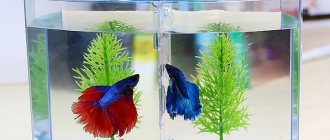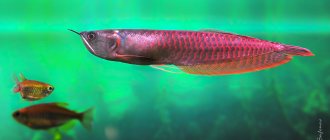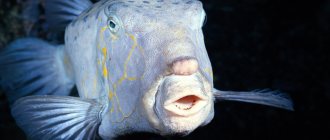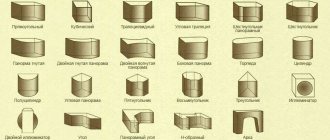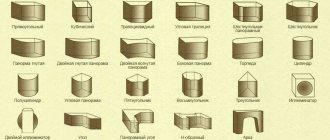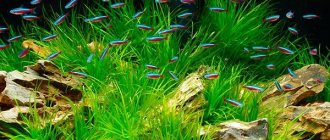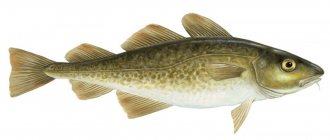Choosing inhabitants for a small aquarium is a whole science, since choosing inhabitants who will be comfortable in a limited space is not so easy. Each type has its own requirements for water hardness, lighting, design, and it can sometimes be very difficult to combine them. The article suggests getting acquainted with the most popular and easy-to-keep fish for a small home.
Origin
“Domestic” fish first appeared in China around the 13th-14th centuries. It was during this period that goldfish began to be bred in the monastery ponds, which gradually changed, acquiring a bright color, but a smaller size.
At the beginning of the 16th century, the idea of populating artificial reservoirs spread in Korea, then in Japan. The Japanese made a special contribution to the development of species - they created new varieties that differed in both size and color. Nowadays, the inhabitants of aquariums differ in shape and color; among them there are owners of bright scales that glow in the dark. Some lovers of the aquatic world prefer to observe the bizarre behavior of real giants. And other aquarists opt for small biotopes.
Decorating the aquarium
To make the aquarium resemble the underwater world, all installed equipment must be camouflaged:
- Place soil 4-5 cm high on the bottom to cover the filter. For the soil in a round aquarium, it is better to use gravel or small dark pebbles;
- plant 2-3 living plants in the ground;
- lower the intestine from the aerator (compressor) into a bamboo hollow tube, from which air bubbles will float beautifully;
- Unfortunately, the limited bottom area will not allow you to decorate a round aquarium with shipwrecks or castle ruins. But some kind of house or shell would fit here. This is both aesthetically pleasing and the fish feel protected in the shelter.
Definition
A small aquarium is considered to be one with a volume of no more than 50 liters and a length of 20-40 cm.
Nanoaquarium is a container with a capacity from 5 liters to 20 liters. You shouldn’t think that its tiny size makes it easier to care for; in fact, keeping such a “crumb” clean and tidy is much more difficult than dealing with a traditional format. The advantages include affordable cost and the ability to install in a small room. Most often the models are cubic or rectangular.
A small amount of water inevitably leads to a serious problem - even the most minor changes immediately affect the health of its inhabitants.
Equipment and arrangement
A small tank should be prepared for the settlement of aquatic inhabitants no worse than its large “brother”.
Before purchasing fry, make sure you have:
- LED lamp that does not heat the water;
- filter of sufficient power;
- compressor;
- heater (preferably with a thermostat);
- plants that are suitable in size, for example, dwarf anubias;
- decor
Beginners may want to consider a fully stocked aquarium that comes with everything they need already installed (such as the Dennerle Nano Cube).
Important! The filter is especially important for a small tank, where any change in equilibrium can lead to the death of all inhabitants. It must pass at least 8 liters of water per hour, have a large filler surface and have water intakes that prevent unwary fish from getting into.
Decor and equipment for a small aquarium
A big problem with small aquariums is the variability of water quality. Creating suitable conditions in a 20-liter reservoir is not an easy task, but it has a solution. Various, even the most insignificant factors, can affect the quality of water, for example, exceeding the number of inhabitants by 1 tail or exceeding the feeding norm. Another major problem is providing the aquarium with oxygen. With a large number and small volume, the oxygen in the water quickly runs out, and the fish suffer from oxygen starvation. We have to solve the problem of optimizing the environment. A filter for a large aquarium is not appropriate here, so we have to solve the problem in other ways.
A regular filter is not suitable because:
- Takes up a lot of space;
- Has great power;
- Creates a current;
- It spoils plants and kills fish.
The only way out is to create an airlift filter with your own hands. It will help solve all the problems of the aqua, but will create additional inconveniences:
- The main one is splashes from the aquarium. This option is extremely inconvenient to place on a desktop. The only way to eliminate the discomfort is to cover the aquarium with a lid.
- Increased noise from the device. This option is acceptable for an office, but sleeping in a room with a running compressor will be quite problematic.
The second problem can be solved by making a silent filter - a spring, instructions and detailed photos of which can be found on the Internet.
General requirements
Due to the tiny volume of the container, not all aquarium inhabitants are suitable for you.
Therefore, you should pay attention to the following criteria:
- Small size. Acceptable body length is 2-6 cm.
- Calm, peaceful character. A lonely fish will certainly get bored, its color will fade, which is why it is recommended to keep aquatic inhabitants in schools, even in small containers.
- Unpretentiousness. It is not easy to create ideal conditions in a 10-liter container, so exotic varieties with a whole list of necessary maintenance rules will not work. It is advisable to choose hybrids; they have stronger immunity.
- Bright color. The criterion is not as important as those previously indicated, but the beautiful colors and shades of scaly bodies will help create an amazing mini-composition, a true work of art.
Shiny neons
The ideal option for an aquarium of approximately 20 liters is peaceful, shiny neons. Thanks to their unpretentiousness, neon chicks will feel great in a 10-liter vessel, but only if their number consists of 4 individuals. It is worth remembering that this type of fish belongs to schooling aquatic inhabitants, so the aquarium should be a little larger.
Paying attention to the appearance of the fish, the distinctive color feature is a shiny blue horizontal stripe, while the body itself has different colors: blue, black, red and blue. By nature, charming neons are friendly, sociable, very active and playful, not picky and not difficult to keep. Gupish and minors will be good neighbors for them.
Danio - rerio
Striped aquarium inhabitants zebrafish - rerio, another ideal option for a 20-liter reservoir. In addition to their cheerful multi-colored color, zebrafish are cheerful, agile and very active. That is why they will become a real decoration for a small aquarium of 20 liters.
They are not picky, as they can live calmly in water with temperatures ranging from 16 to 30 degrees, they love vegetation and are content with good natural light. It is preferable to feed with live food, for example, daphnia, cyclops or live bloodworms. They spawn easily and do best in schools.
Friendly guppies
The most common inhabitant of home aquariums, guppies, do not cause any trouble for their owners, which is why they are considered the best option for beginning aquarists. In addition, guppies, in addition to being unpretentious, have many beautiful colors and are fertile. After just a few weeks of living in a 20-liter aquarium, you can find a huge number of fry, which are quite difficult to catch.
Guppies eat absolutely everything and can survive a week-long hunger strike just fine, tolerate absolutely any temperature and can be content with natural light. But in order for the color of the fish to acquire a more saturated palette, it is worth installing artificial lighting, paying attention to frequent feeding and periodically changing the water, adding approximately 1.5 liters of water to a 20-liter aquarium once a week.
Cardinals
A beautiful slender cardinal, it is considered one of the few fish that feel great in a small aquarium of 20 liters. Cardinals have a beautiful brown-olive hue with a silver tint. The caudal fin is bright red and has small yellow stripes. in small spaces of the aquarium it can reach approximately 4-5 cm.
Cardinals are friendly fish, which is why it is better to keep them in small schools in the company of red neon, zebrafish or rhodostomus. To make the cardinals feel at home, it is necessary to decorate a small 20-liter pond with vegetation. Dry mixtures and live food are ideal as food.
Norman's Blue Eye
The cute schooling blue-eyed fish is an ideal solution for a small aquarium. Experts are confident that even in a 10-liter vessel these fish will be able to swim to their heart’s content. A distinctive feature of the blue-eye is the bright frame of the eye shell, which glows with neon light, thereby making the atmosphere of the aquarium extremely charming.
The peaceful but slightly shy blue-eye will get along with peaceful fish species, but it is better to keep large inhabitants away. The blue-eye loves various shelters, plant thickets, dark soil and a little free space. It eats almost all types of live food and does not disdain substitutes.
Luxurious cockerels
For beautiful betta fish, owners of luxurious fins and bright colors, a pond of a small number of liters is also ideal. However, to keep these fish it is necessary to create certain conditions. For example, too low or too high a temperature can lead to diseases that will lead to the death of bettas. A mandatory condition is to change the water, approximately several liters weekly,
The fish's daily diet consists of live food. You can use frozen food, or dilute their diet with flatworms or snails. They get along with swordtails, minors, catfish, gouramis, etc. But active neons and barbs can inadvertently damage the gorgeous fin of a cockerel, which will lead to fighting fights.
Not every aquarist can place a large aquarium at home. Others don't find enough time to properly care for it. In such cases, the best solution would be a small 20 liter aquarium. It will take up little space, it is quite possible to place it on a desk and it will take less time to care for. It is suitable for beginner fish breeders.
Soil is used to create an ecosystem. Algae is planted in it and the decorations are strengthened. It is easier to purchase ready-made primer, which is sold in various colors and materials. You are allowed to collect soil yourself, but this option is more suitable for already experienced aquarists.
Filling begins directly with laying the soil. Before placement, the soil should be treated. If the soil is made of natural materials, it should be filtered and calcined to destroy bacteria that harm the fish. The optimal soil thickness for a 20-liter aquarium is 3-4 cm.
Most Popular
Let's consider what aquarium fish for small containers exist.
Cockerels
Bright fighting inhabitants with a large beautiful tail and a cool disposition. They do not get along well with others, which is why it is best to house them in isolation. The body length is from 5 to 10 cm, these are ideal fish for a 5 liter aquarium.
Guppy
If you are a beginner and buying fish for the first time, then it is better to start with guppies. These are unpretentious little ones, the males of which have a beautiful pearlescent color.
Advantages:
- Their length does not exceed 3 cm.
- They consume very little food.
- They do not need complex decor, labyrinths and grottoes. The simplest design is quite enough.
When considering what kind of fish to keep in a small aquarium, first of all pay attention to guppies.
Corridors
Let's continue to consider which fish can be kept in a small aquarium. These are miniature catfish that will also be quite comfortable in a small tank.
Important! You should purchase 2-3 corydoras at once, since these schooling fish cannot live alone.
Danio
These are oblong, hyperactive babies, so they will need free space for games and entertainment. A maximum of two males can be placed in a 10 liter container.
Catfish
Owners of a 20 liter aquarium (which is also considered small) may consider raising catfish. They prefer to stay in the lower layers, at the bottom, performing the functions of aquarium cleaners.
Important! Remember that these little ones can grow up to 10 cm, so one small tank will eventually become too small for two or more individuals. But to prevent the catfish from getting bored, you can add a small flock of nimble guppies to it.
Microassortment galaxy
This is a tiny fish that prefers to live with a school of representatives of its species. Body length – no more than 3 cm.
Suitable for tanks with a volume of 20 liters or more, since for comfortable living it needs relatives (a flock of at least 8-10 pieces). They will also need plants and decorative shelters.
Amanda's tetra
Another type of schooling fish. The parameters are similar to microassembly, but more friendly. Two Amanda tetras can easily get along with guppies or zebrafish. It is important to note that they need free-floating plants to provide shade.
Formosa
This is a schooling fish with a body length of up to 2 cm. It is inferior in beauty to microrasbora or tetra amanda, however, schools of 10 formosa can be safely settled in tanks of 10 to 15 liters. If you don’t know what kind of fish to keep in a tiny aquarium, then take a closer look at the Formosa.
Pecilia
Pecilia is one of the most popular aquarium fish. The length of its body is approximately 4 cm; a couple of such individuals will feel quite comfortable in a 20-liter aquarium. This species is active, so don’t overwhelm the aquarium with decorations—it’s better to give them a place to swim.
Otocinclus
Otocinclus is another popular species of aquarium catfish. Unlike other species, they are calmer and timid, and get along well in small aquariums with another otocinclus and other fish. They are afraid of large inhabitants of waters, so it is better not to add species exceeding 5 cm in length to them.
The best labyrinth fish for an aquarium
The peculiarity of labyrinth fish is that they breathe directly with atmospheric air, which means they do not require additional equipment in the aquarium. In nature, they live in shallow swampy bodies of water with muddy water and can remain on land for a long time without risk to life.
Golden gourami - the hardiest fish
5
★★★★★
editorial assessment
99%
buyers recommend this product
See review▶
Golden, dark-spotted gouramis are often found in home aquariums. They survive even in a small jar. The size of fish in a spacious aquarium can reach 15 cm, but usually at home they are smaller. Gourami live in domestic ponds for up to 7-8 years. For the most comfortable existence of the species, soft lighting is recommended, the volume of water is for 4 fish from 100 liters, the optimal temperature is 24-26 degrees.
Pets eat both live and prepared food. However, they are prone to overeating, so you need to accurately dose the amount of food. Gourami cannot live in open aquariums without plants. Any flora, including floating, is welcome.
Pros:
- hardy appearance;
- lives in almost any habitat;
- long life expectancy;
- undemanding to food;
- low price (up to 100 rubles).
Minuses:
- are difficult to get along with some fish.
Males of this species are aggressive towards each other. They should not be placed in an aquarium with small fish, otherwise the gouramis will start hunting them. There is also a whole list of fish with which they do not get along. Among them are guppies, goldfish, cockerels, cichlids and others.
Macropod is the best choice for a beginner aquarist
5
★★★★★
editorial assessment
96%
buyers recommend this product
See review▶
The macropod or paradise fish is very beautiful. Its blue and red striped body and bright red fins make it a welcome guest in many aquariums. It is better to keep them alone or in opposite-sex pairs - the males do not get along with each other. You can house the fish of paradise with pets of a similar size.
The species easily survives in water with low oxygen content. Macropods are undemanding to temperature and water level. In summer they can even live in unheated outdoor ponds. They feed on any food, due to which they are considered ideal fish for a novice breeder.
Pros:
- price (from 75 rubles);
- beautiful appearance and bright color;
- live without aeration and filtration;
- suitable for aquariums of any size;
- tolerate any water parameters.
Minuses:
- may jump out of the aquarium.
Macropods are excellent jumpers, so the aquarium with them must be covered with a lid.
Marbled gourami - a noble inhabitant of the aquarium
4.9
★★★★★
editorial assessment
94%
buyers recommend this product
See review▶
Marble pets are similar to other gouramis in everything except their unusual color. They are also unpretentious to food and living conditions. It is recommended to have no more than one male per aquarium - these beauties do not have the same personalities as other types of gourami. They reproduce easily - all you need is a spacious aquarium.
Marbled gourami are the result of artificial selection; they are not found in nature. The size of the fish can reach 15 cm, but usually the body length is shorter. The average lifespan of fish is 4-6 years.
Pros:
- do not require the purchase of equipment for the aquarium;
- live long;
- unpretentious in food;
- sold in all stores;
- easy to reproduce.
Minuses:
- They don’t get along with everyone.
Marbled gouramis can be kept even in the absence of artificial aeration, but in this case you need to ensure that the temperature difference between water and air is small.
Cockerel is the brightest fish
4.9
★★★★★
editorial assessment
93%
buyers recommend this product
See review▶
Bettas or betta fish are loved by aquarists for their unusual bright appearance and fearless character. The size of the breed is small: the body length of males is about 5 cm, and females – up to 4 cm. However, in large bodies of water such fish can grow up to 10 cm. A distinctive feature of the cockerels is their interesting multi-colored color. They come in one, two or many shades at once, combining all the colors of the rainbow. Males are usually slightly brighter than females.
Betta fish are quite easy to care for, but you need to follow some rules. Each individual should have at least 3-4 liters of water. It needs to be changed regularly - these pets do not like a dirty, muddy environment. The temperature should not fall below 18 degrees. To prevent diseases, you can sometimes add a little table salt to the aquarium.
Pros:
- beautiful unusual color, luxurious fins and tail;
- small size;
- live in almost any water;
- Can be placed in small and large aquariums.
Minuses:
- It is difficult to maintain the brightness of the color.
The brightness of the colors of the bettas is affected by the quality of lighting, nutrition and the general condition of the fish. Due to meager food, they become paler, but during skirmishes with other fish they become most bright.
Check-in rules
Many types of small fish are unpretentious, but this does not mean that comfortable conditions should not be created for them.
Before moving in, make sure that:
- The water temperature corresponds to what the fish need.
- You have food that suits the purchased species.
- The water in the aquarium is clean and the filter is working properly.
- The water maintains the correct alkaline balance.
What and how to equip
To keep the water clean, a compact bottom filter with gravel is placed in a round aquarium. The principle of operation of such a filter: a pump drives a layer of water through it, dirt is retained by gravel - the filter material. The logical pattern is that the larger the volume of the aquarium, the more powerful the pump should be, and the more expensive the filter. A filter with a minimally powerful pump is suitable for a volume of 10 liters. If you are greedy and do not install a filter, you will have to change the water daily, which is very stressful for the fish and will ultimately kill them.
A round aquarium has a relatively small surface area, which leads to oxygen deficiency. A special compressor will saturate the water with vital air. You need to buy it labeled “for round aquariums.” The principle of choice is the same as for filters - the larger the volume of the aquarium, the more powerful and more expensive the compressor. For a container of 20-40 liters, a compressor with minimal power is suitable.
Lighting is necessary not only for fish, but also for fish. Thanks to light, their leaves enrich the water with oxygen. It is better to place the lamp on top, not close to the glass, so that it does not burst. It is best to use regular incandescent lamps, because... their spectrum is as close as possible to the solar spectrum. In this case, the optimal brightness is set at the rate of 1-2 watts per 1 liter of water. It is advisable to buy round aquariums with lighting included.
Everything is not so complicated, and even a novice amateur can properly arrange a round aquarium.
Options for stocking very small aquariums
Aquariums with volumes from one to ten liters are called nanoaquariums, and they are often unsuitable for fish. It is difficult to find aquarium fish that are suitable for beginners for a small aquarium of 1 liter or 2 liters. That's why there are other creatures that are bred in them.
Shrimps
Shrimp can be a charming resident of a nanoaquarium. These little ones need less water than fish, so two small shrimp can easily coexist in a tank with a volume of only two liters. Their different types differ in their care characteristics, but they are all very beautiful.
Remember that fish in a 2-liter aquarium will feel uncomfortable, so you shouldn’t torment aquatic inhabitants; it’s better to populate a compact container with cute shrimp.
crustaceans
Dwarf crayfish can also be residents of small aquariums. A couple of these need a tank of about 10 liters as they need room to move around. Crustaceans can easily get along with small fish.
Hymenochirus frogs
This is one of the new species of aquarium frogs that has gained popularity quite recently. They have a body length of about 4 centimeters, so they do not require a large aquarium. For a couple of such individuals, an aquarium with a volume of no more than 3 liters will be enough, if you do not know which fish are suitable for it. These babies are very agile, so it is important to remember to close the aquarium to prevent them from jumping out.
Separate conversation
There are fish to which it is impossible to apply general concepts of population density.
The diversity of their species and behavioral characteristics does not allow us to talk about a uniform population density. These are fish that are jealous of their own territory. It is believed that a slight overpopulation may slightly soften their aggressive nature.
Small cichlids, up to 10 cm long (sage, blackstripe, sun), need aquariums of at least 40-60 liters per pair. As the aquarium grows, the population density increases. For example, up to a dozen black-striped cichlases can “live” in 150 liters.
Medium-sized cichlids, up to 30 cm (small Tangani and Malawian) need a larger aquarium - from 150 liters. As mentioned earlier, slight overpopulation is allowed - the volume is calculated from 10 liters per individual. Arranging the bottom will also help solve the problem of aggressiveness - they just need places to hide (, snags, large bushy plants).
Bottom fish - suckers and burrowers
The number of catfish and bots, as a rule, is not taken into account in the total number of inhabitants of the aquarium, but their size should not be overlooked. For example, for 1 ancistrus you will need an aquarium of 50 liters, for 1 plecostomus - already 250.
Labyrinth fish
An exception to the general rules are labyrinth fish - they are practically indifferent to the oxygen content in the water. For example, a single cockerel will feel fine in almost a glass of water, and a couple of gouramis will feel fine in a 20-liter aquarium.
Decorative elements
To create an original design for a 30-liter aquarium, you need to take care of decorative elements. Thanks to decorations, you can decorate an artificial pond in a different style. The following elements are used for these purposes:
- various “wallpapers” for the back wall of the aquarium;
- driftwood;
- shells;
- locks;
- ship models and more.
After recreating the atmosphere of the underwater kingdom, it’s time to think about what kind of fish to put in an artificial pond and how many snails should be in the aquarium.
Settling the aquarium
You can keep several types of fish in an aquarium, but if you wish, it is permissible to limit yourself to one breed, the main thing is not to overpopulate the artificial reservoir. The most common species that are suitable for keeping in a small container are guppies. With a capacity of 30 liters, up to 20 individuals can comfortably exist in the container. In addition, artificial reservoirs are populated with the following species of small fish:
- platies, molinesias and swordtails (up to 10 individuals);
- cockerels and macropods (most often these species are kept alone, but since 30 liters of space is a lot for one individual, you can choose fish that can exist next to them as neighbors);
- catfish (5 individuals each);
- tetras and thorns (no more than 10 fish).
If there is a desire to create a reservoir with a “combined” population, it is recommended to select individuals in this way:
- Sumatran barbs (5 pcs.), mossy barbs (10 pcs.), speckled catfish (3 pcs.);
- neons (10 pcs.), ancitrus catfish (3 pcs.), mossy barbs (5 pcs.), zebrafish (4 pcs.);
- zebrafish (5 pcs.), guppies (10 pcs.), white catfish (3 pcs.);
- mollies (5 pcs.), swordtails (5 pcs.), neons (10 pcs.), ancitrus catfish (3 pcs.).
Often other types of underwater inhabitants are added to the fish. How many snails are allowed in a 30 liter container? As a rule, 10 of these individuals are enough.
Keeping fish and decorating aquariums is a fascinating activity. With some creativity and some effort, you can turn even a small “house” into a real work of art.
Look at the beautiful inhabitants of this small house.
https://youtube.com/watch?v=6ZLQH1nSmCY%3F
What fish are suitable for keeping in a round aquarium?
The round shape limits the movement of fish, in addition, it creates a specific lens effect. All this negatively affects the health of the fish. Nervous, weak individuals cannot survive in such harsh conditions. Therefore, in order for a round aquarium to please the eye, you need to carefully approach the issue of choosing guests.
It is necessary to populate a round aquarium with small, non-schooling fish in limited quantities. Overpopulation will immediately affect the health of residents. Cockerels, lalius, catfish (they are also useful because they clean the walls of the aquarium), guppies, small gouramis, ancistrus, swordtails, platies, molynesias, neons, freshwater shrimp and decorative snails take root well in a round aquarium.
It is better to feed the fish in a round aquarium dry food in small portions so that the fish eat it immediately without leaving any residue. Otherwise, excess feed will cake on the bottom and pollute the water.
Rule two: calculating surface area
The larger the surface area of the water, the more actively the water is saturated with oxygen, which in turn meets the needs of a larger number of fish. Therefore, surface area directly affects how many fish can be kept in an aquarium. A tall, narrow aquarium can hold the same amount of water as a short, wide aquarium, but they have different surface areas.
The surface area of the water is calculated as follows: the length of the tank is multiplied by the width. According to the water surface area rule, the aquarium should be provided with 12 sq. cm of surface area per 1 cm of fish.
However, this calculation has the same disadvantages as the previous rule. For example, it is designed only for fairly slender fish, which is not always the case. If the aquarium contains more rounded fish, the calculation should be 20 sq. cm per 1 cm of fish.
The method of calculating by surface area is not ideal, because many fish need more oxygen, and therefore more surface area. So all the same goldfish need water highly saturated with oxygen, as well as fish that naturally live in fast streams and rivers. The only advantage of this method is that it takes into account unusual shapes of aquariums.
